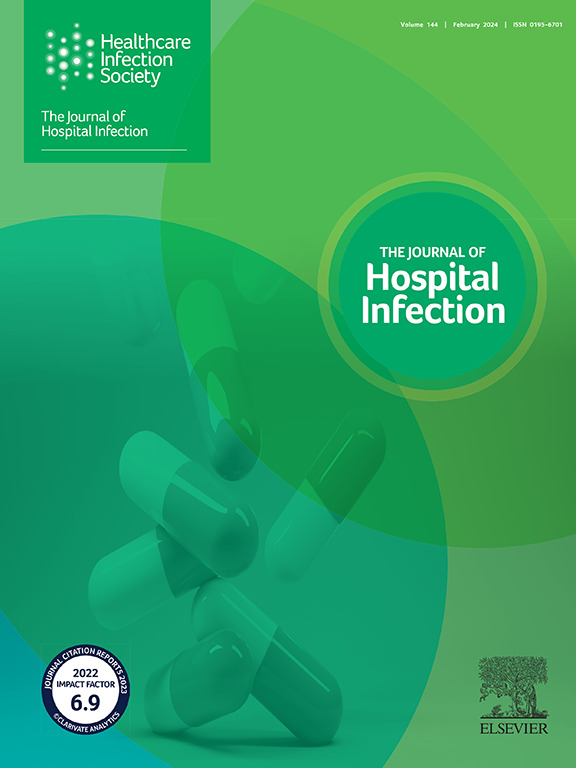2011年至2022年韩国重症监护病房血液感染患者中微生物发病率趋势:来自韩国国家医疗保健相关感染监测系统(KONIS)的数据
IF 3.1
3区 医学
Q1 INFECTIOUS DISEASES
引用次数: 0
摘要
背景:评估重症监护病房(icu)血流感染患者中微生物分布和耐多药病原菌发病率的趋势。方法:回顾性分析使用韩国国家卫生保健相关感染监测系统的数据。研究血流感染(bsi)患者微生物分布和耐多药病原体的年度趋势。结果:bsi患者的金黄色葡萄球菌感染发生率从2011年的33.1 / 10万患者-天下降到2022年的9.7 / 10万患者-天。肺炎克雷伯菌引起的脑损伤发病率从2015年的每10万患者日6.4例增加到2022年的12.1例。2011年耐甲氧西林金黄色葡萄球菌(MRSA)致bsi发病率[28.8/10万患者日;(2022年为7.3/10万患者日)和MRSA菌株百分比[2011年为91.8%;在整个研究期间下降了76.7%[2022年]。耐亚胺培南肺炎克雷伯菌引起的脑梗死发生率从2011年的0.3 / 10万患者日显著上升至2021年的6.1 / 10万患者日,耐亚胺培南肺炎克雷伯菌比例从2011年的4.3%上升至2022年的48.5%。2011 - 2021年,耐亚胺培南铜绿假单胞菌引起的BSI发病率呈上升趋势。结论:重症监护室MRSA所致脑梗死发生率下降,而耐亚胺培南肺炎克雷伯菌和耐亚胺培南铜绿假单胞菌所致脑梗死发生率呈上升趋势。在过去的几十年里,bsi中革兰氏阳性菌向革兰氏阴性菌发生了重大转变。本文章由计算机程序翻译,如有差异,请以英文原文为准。
Trends in incidence rates of micro-organisms among patients with bloodstream infections at intensive care units in South Korea from 2011 to 2022: data from the Korean National Healthcare-Associated Infections Surveillance System (KONIS)
Background
Trends in the microbiological distribution and incidence rates of multi-drug-resistant pathogens in patients with bloodstream infections (BSIs) in intensive care units (ICUs) were evaluated.
Methods
This retrospective analysis was conducted using data from the Korean National Healthcare-Associated Infections Surveillance System. Annual trends in micro-organism distributions and multi-drug-resistant pathogens in patients with BSIs were investigated.
Results
The incidence rate of BSI due to Staphylococcus aureus decreased from 33.1 per 100,000 patient-days in 2011 to 9.7 per 100,000 patient-days in 2022. The incidence rate of BSI due to Klebsiella pneumoniae increased from 6.4 per 100,000 patient-days in 2015 to 12.1 per 100,000 patient-days in 2022. The incidence rate of BSI due to meticillin-resistant S. aureus (MRSA) (28.8/100.000 patient-days in 2011; 7.3/100,000 patient-days in 2022) and the percentage of MRSA strains (91.8% in 2011; 76.7% in 2022) decreased throughout the study period. The incidence rate of BSI due to imipenem-resistant K. pneumoniae increased significantly from 0.3 per 100,000 patient-days in 2011 to 6.1 per 100,000 patient-days in 2021, and the percentage of imipenem-resistant K. pneumoniae strains increased from 4.3% in 2011 to 48.5% in 2022. The incidence rate of BSI due to imipenem-resistant Pseudomonas aeruginosa showed an increasing trend from 2011 to 2021.
Conclusion
The incidence rate of BSI due to MRSA in ICUs decreased, whereas the incidence rates of BSIs caused by imipenem-resistant K. pneumoniae and imipenem-resistant P. aeruginosa in ICUs showed an increasing trend. Over the past decades, there has been a significant shift from Gram-positive bacteria to Gram-negative bacteria in BSIs.
求助全文
通过发布文献求助,成功后即可免费获取论文全文。
去求助
来源期刊

Journal of Hospital Infection
医学-传染病学
CiteScore
12.70
自引率
5.80%
发文量
271
审稿时长
19 days
期刊介绍:
The Journal of Hospital Infection is the editorially independent scientific publication of the Healthcare Infection Society. The aim of the Journal is to publish high quality research and information relating to infection prevention and control that is relevant to an international audience.
The Journal welcomes submissions that relate to all aspects of infection prevention and control in healthcare settings. This includes submissions that:
provide new insight into the epidemiology, surveillance, or prevention and control of healthcare-associated infections and antimicrobial resistance in healthcare settings;
provide new insight into cleaning, disinfection and decontamination;
provide new insight into the design of healthcare premises;
describe novel aspects of outbreaks of infection;
throw light on techniques for effective antimicrobial stewardship;
describe novel techniques (laboratory-based or point of care) for the detection of infection or antimicrobial resistance in the healthcare setting, particularly if these can be used to facilitate infection prevention and control;
improve understanding of the motivations of safe healthcare behaviour, or describe techniques for achieving behavioural and cultural change;
improve understanding of the use of IT systems in infection surveillance and prevention and control.
 求助内容:
求助内容: 应助结果提醒方式:
应助结果提醒方式:


